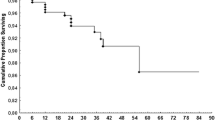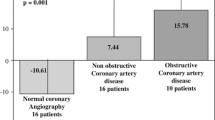Abstract
Stress-echocardiography (SE) has been proven to be a valuable method for the diagnosis of coronary artery disease. For patients who cannot exercise, pharmacological stress-echocardiography represents an alternative method for the induction of cardiovascular stress. Few studies exist concerning the value of dipyridamole-SE for the detection of restenosis in patients after primary successful PTCA. It has been demonstrated that the addition of atropine can significantly increase the diagnostic potential of dipyridamole-SE, especially in patients with 1- or 2-vessel disease. The purpose of our study was to investigate the diagnostic value of high-dose dipyridamole-SE plus atropine (DASE) for the detection of restenosis after primary successful PTCA. We investigated 65 patients 3–6 months after PTCA before a control angiography was performed. Restenosis was defined as > 70% lumen narrowing, determined by quantitative coronary angiography. In 20/27 patients with restenosis the DASE was pathologic (sensitivity 74%), in 34/38 patients without restenosis the DASE was normal or showed no induced WMA (specificity 89%). Patients with tight restenosis (> 90%) were always correctly detected by DASE. Concerning the different vessels, restenosis of the LAD was correctly predicted by DASE in 11/12 patients, restenosis of the LCX in 6/9 patients and restenosis of the RCA in 8/11 patients. Conclusions: From our results of our study we conclude that DASE is a reliable diagnostic method for the non-invasive evaluation of patients after PTCA. DASE can identify patients with relevant restenosis after PTCA and help to select those patients who will probably benefit from further coronary interventions.
Similar content being viewed by others
References
Vlay SC, Chernilas J, Lawson WE, Dervan JP. Restenosis after angioplasty: Don't rely on the exercise test. Am Heart J 1988; 117: 980-986.
Honan MW, Bengston JR, Pryor DB, Rendall DS, Lee KL, Stack RS et al. Exercise treadmill testing is a poor predictor of anatomic restenosis after angioplasty for acute myocardial infarction. Circulation 1989; 80: 1585-94.
Bengston JR, Mark D, Honan M, Stack RS, Lee LK, Pryor DB et al. Detection of Restenosis after elective percutaneous transluminal coronary angioplasty using the exercise treadmill test. Am J Cardiol 1990; 65: 28-34.
Hecht HS, Shaw, RE, Bruce TR, Stertzer SH, Myler KM: Usefulness of tomographic thallium-201 imaging for detection of restenosis after percutaneous transluminal angioplasty. Am J Cardiol 1990; 66: 1314-18.
Hecht HS, Shaw RE, Chin HL, Ryan C, Stertzer SH, Myler RK: Silent ischemia after coronary angioplasty: evaluation of restenosis and extent of ischemia in asymptomatic patients by tomographic thallium-201 exercise imaging and comparison with symptomatic patients. J Am Coll Cardiol 1991; 17: 670-677.
Breisblatt WM, Weiland FL, Spaccavento LJ: Stress thallium-201 after coronary angioplasty predicts restenosis and recurrent symptoms. J Am Coll Cardiol 1988; 12: 1199-1204.
Pirelli S, Danzi G, Alberti A, Massa D, Piccalo G, Faletra F et al. Exercise Thallium Scintigraphy versus High-dose Dipyridamole Echocardiography for Detection of Asymptomatic Restenosis after Coronary Angioplasty. Am J Cardiol 1993; 71: 1052-1056.
Fioretti PM, Pozzoli MMA, Ilmer B, Salustri A, Comel JH, Roelandt JRTC et al: Exercise echocardiography versus thallium-201-SPECT for assessing patients before and after PTCA. Eur Heart J 1992; 13: 213-219.
Hecht H, DeBord L, Shaw R, Dunlap R, Ryan C, Stertzer S et al. Usefulness of supine stress echocardiography test for the detection of restenosis after percutaneous transluminal coronary angioplasty. Am J Cardiol 1993; 71: 293-296.
Kramer PH, Beauchamp GD, Vacek JL, Rowland J, Crouse LJ: Exercise echocardiography predicts restenosis after coronary angioplasty Circulation 1990,82(Suppl. III): III-192.
Aboul-Enein H, Bengston JR, Adams D, Mostafa M, Ibrahim M, Hifny A et al. Effect of the degree of effort on exercise echocardiography for the detection of restenosis after coronary artery angioplasty. Am Heart J 1991; 122: 430-437.
Mertes H, Erbel R, Nixdorff U, Mohr-Kahaly S, Krüger S, Meyer J: Exercise echocardiography for the evaluation after nonsurgical coronary artery revascularisation J Am Coll Cardiol 1993; 21: 1087-1093.
Stempfle HU, Brandl B, Krüger TM, Theisen K, Angermann CE: Detection of coronary restenosis after PTCA by combined transesophageal echocardiography and atrial pacing. 1st International Symposium on Stress Echocardiography, Pisa 1993.
Hoffmann R, Kleinhans E, Besten M, Flachskampf PA, Lambertz H, Hanrath P: Transesophageal pacing echocardiography for identification of patients with restenosis after percutaneous transluminal angioplasty. J Am Coll Cardiol 1992; 19: 54A.
Pirelli S, Danzi GB, Alberti A, Massa D, Piccalo G, Faletra F, Picano E: Comparison of usefulness of high-dose dipyridamole echocardiography and exercise electrocardiography for detection of asymptomatic restenosis after coronary angioplasty. Am J Cardiol 1991; 67: 1335-1339.
Coma-Canella I, Sobrino N, Calvo L. Detection of restenosis with dobutamine stress test after coronary angioplasty. Am Heart J 1992; 124: 1196-1204.
Heinle SK, Lieberman EB, Ancukiewicz M, Waugh RA, Bashore TM, Kisslo J. Usefulness of dobutamine echocardiography for detecting restenosis after percutaneous transluminal coronary angioplasty. Am J Cardiol 1993; 72: 1220-1225.
Picano E, Pingitore A, Conti U, Kozakova M, Boem A, Cabani E et al. Enhanced sensitivity for the detection of coronary artery disease by addition of atropine to dipyridamole echocardiography. Eur Heart J 1993; 14: 1216-1222.
Previtali M, Lanzarini L, Ferrario M, Tortorici M, Mussini A, Montemartini C: Dobutamine versus dipyridamole echocardiography in coronary artery disease. Circulation 1991; 83:III 27-31.
Lanzarini L, Feteveau R, Poli A et al.:Comparison of dobutamine and dipyridamole stress-echocardiography with exercise test for coronary artery disease diagnosis J Am Coll Cardiol 1993; 21: 89A.
Boccanelli A, Piazza V, Gerco C et al.: Comparison of diagnostic value of dipyridamole and dobutamine stress echocardiography in coronary artery disease J Am Coll Cardiol 1993; 21: 393A.
Beleslin B, Ostojic M, Stepanovic J, Djordjevic-Dikic, Stoikovic S, Nedelkovic S et al.: Stress Echocardiography in the Detection of Myocardial Ischemia. Head-to-Head Comparison of Exercise, Dobutamine and Dipyridamole Tests. Circulation 1994; 90: 1168-1176.
Schiller N, Shah P, Crawford M, DeMaria A, Devereux R, Feigenbaum H et al. for the American Society of Echocardiography Committee on standards, subcommitte on quantification of two-dimensional echocardiograms (1989): Recommendations for the quantification of the left ventricle. J Am Soc Echo 1989; 2: 358-367.
Hernandez RA, Macaya C, Iniguez A et Al. Midterm outcome of patients with asymptomatic restenosis after coronary balloon angioplasty. J Am Coll Cardiol 1992; 19: 1402-1409.
Holmes DR, Vlietstra RE, Smith HC, Vetrovec GW, Kent KM, Cowley MJ et al. Restenosis after percutaneous transluminal coronary angioplasty (PTCA): a report from the PTCA Registry of the National Heart, Lung, and Blood Institute. Am J Cardiol 1984; 53: 77C-81C.
Zaidi AR, Hollman J, Gallan K. Predictive value of chest discomfort for restenosis following successful coronary angioplasty (PTCA). Circulation 1985; 72,Suppl III: 456-461.
Levine S, Ewels CJ, Rosing DR, Kent KM. Coronary angioplasty: Clinical and angiographic follow-up. Am J Cardiol 1985; 55: 673-676.
Hecht H, DeBord L, Shaw R, Dunlap R, Ryan C, Stertzer S et al. Usefulness of supine bicycle stress echocardiography test for the detection of restenosis after percutaneous transluminal coronary angioplasty. Am J Cardiol 1993; 71: 293-296.
Hoffmann R, Lethen H, Kleinhans E, Weiss M, Flachskampf F, Hanrath P. Comparative evaluation of bicycle and dobutamine stress echocardiography with perfusion scintigraphy and bicycle electrocardiogram for identification of coronary artery disease. Am J Cardiol 1993; 72: 555-559.
Marwick T, D'Hondt A, Baudhuin T, Willemart B, Wijns W, Detry J. Optimal use of dobutamine stress for the detection and evaluation of coronary artery disease: Combination of echocardiography and scintigraphy, or both? J Am Coll Cardiol 1993; 22: 159-167.
Desmet W, De Scheerder I, Piessens J. Limited value of exercise testing in the detection of silent restenosis after succesful coronary angioplasty. Am Heart J 1995; 129: 452-459.
Salustri A, Fioretti P, McNeill A, Pozzoli A, Roelandt JRTC. Pharmacological stress echocardiography in the diagnosis of coronary artery disease and myocardial ischemia: a comparison between dobutamine and dipyridamole. Eur Heart J 1992; 13: 1356-1362.
Ferrara N, Longobardi G, Nicolino A, Acanfora D, Odierna L, Furgi G et al. Effect of Beta-Adrenoceptor Blockade on Dipyridamole-Induced Myocardial Asynergies in Coronary Artery Disease. Am J Cardiol 1992; 70: 724-727.
Weissmann NJ, Jevangie MW, Guerrero JC, Weyman AE, Picard MH. Effect of betablockade on dobutamine stresse-chocardiography. Am Heart J 1996; 131: 698-703.
Lattanzi F, Picano E, Bolognese L, Piccinimo C, Sarasso G, Orlandini A et al. Inhibition of dipyridamole-induced ischemia by antianginal therapy in humans. Correlation with exercise electrocardiography. Circulation 1991; 83: 1256-1262.
Sheikh KH, Bengston JR, Helmy et al. Relation of quantitative coronary lesion measurements to the development of exerciseinduced ischemia assesed by exercise echocardiography. J Am Coll Cardio 1990; 15: 1043-1051.
Segar DS, Brown SE, Sawada SG, Ryan T, Feigenbaum H. Dobutamine stress echocardiography: Correlation with coronary lesion severity as determined by quantitative angiography. J Am Coll Cardiol 1992; 19: 1197-1202.
Mazeika P, Nadazdin A, Oakley C: Prognostic value of dobutamine echocardiography in patients with high pretest likehood of coronary artery disease. Am J Cardiol 1993; 71: 33-39.
Picano E, Severi S, Michelassi C, Lattanzi F, Masini M, Orsini E et al. Prognostic importance of dipyridamole-echocardiography test in coronary artery disease. Circulation 1989; 80: 450-457.
Krivokapisch J, Child J, Gerber R, Lem V, Moser D: Prognostic usefulness of positive or negative exercise stress echocardiography for predicting cardiac events in ensuing twelve months. Am J Cardiol 1993; 71: 646-651.
Flachskampf FA, Hoffman R, vom Dahl J, Lethen H, Hanrath P. Functional Assessment of PTCA results by stress echocardiography: when and how to test. Eur Heart J 1995;16,Suppl J: 31-34.
Author information
Authors and Affiliations
Rights and permissions
About this article
Cite this article
Scherhag, A.W., Pfleger, S., Schreckenberger, A.B. et al. Detection of patients with restenosis after PTCA by dipyridamole-atropine-stress-echocardiography. Int J Cardiovasc Imaging 13, 115–123 (1997). https://doi.org/10.1023/A:1005745908633
Published:
Issue Date:
DOI: https://doi.org/10.1023/A:1005745908633




